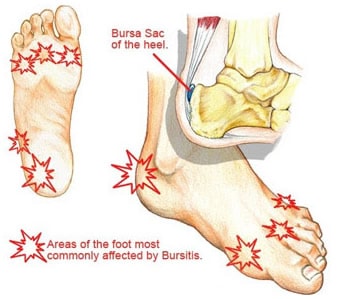Connect With Us
Bursitis
What is bursitis?

Bursae are small, fluid-filled sacs that cushion and lubricate your joints. Most large joints in your body have bursae, including the ankle, heel, and base of your toes. Bursitis occurs when one or more of these sacs become irritated and inflamed.
What are the symptoms of bursitis?
Bursitis symptoms vary depending on which joint is affected. Common symptoms of bursitis include:
- Pain in the heel, ankle, or foot
- Pain that worsens while walking or running, or touching the area
- Joint swelling, warmth, or redness
- Stiffness in the foot or ankle
Pain associated with bursitis may become worse when you stand on your tiptoes or bend your ankle upward.
What causes bursitis?
The most common causes of bursitis are repetitive motions, such as walking, running, or jumping that cause gradual damage to the bursae. You may be at greater risk of developing bursitis if you:
- Begin an intense workout regimen
- Suddenly increase exercise intensity without proper conditioning
- Have a history of arthritis caused by inflammation
Even if you don’t play sports or exercise, spending a lot of time on your feet can increase your risk of getting bursitis
Who gets bursitis?
Bursitis can affect anyone, but certain factors may make you more susceptible, such as:
- Advanced age
- Hobbies or occupations that require a lot of walking or running
- Medical conditions such as arthritis and diabetes
If you have bursitis or are at higher risk of developing this condition, Dr. Horak or Dr. Shauger teach you preventive methods and techniques to protect your joints.
How do you diagnose and treat bursitis?
First, Dr. Horak or Dr. Shauger perform a physical exam and review your medical history. They may ask you to stand on your toes or bend your foot upward. They may also take imaging tests, such as an X-ray, MRI or ultrasound, to rule out any other possible conditions.
Then, they work with you to create a personalized bursitis treatment plan. Depending on your needs, treatment for bursitis may include:
- Avoiding activities that cause pain
- Icing the affected joint
- Anti-inflammatory medicines
- Cortisone injections
- Custom foot or ankle orthotics
- Ultrasound therapy to reduce inflammation
- Physical Therapy
Most of the time, bursitis improves with conservative treatment. In rare cases. Dr. Horak or Dr. Shauger may recommend surgery to drain a severely inflamed bursa.
If you suffer from foot, ankle, or heel pain, call American Surgeons Group or book an appointment online.
